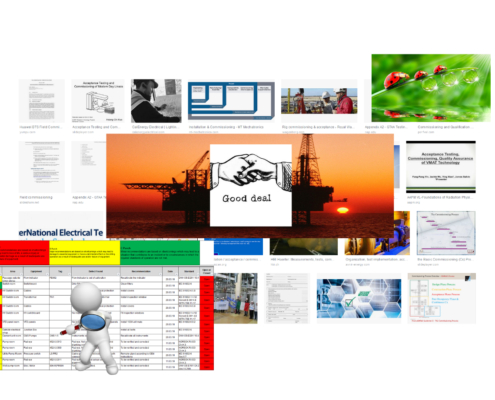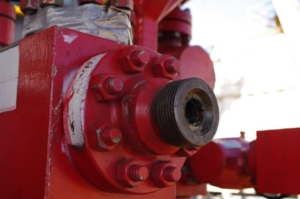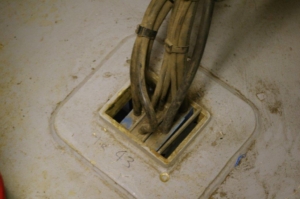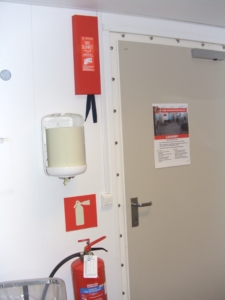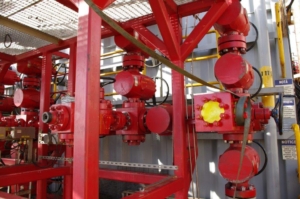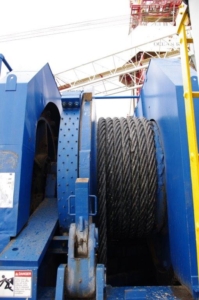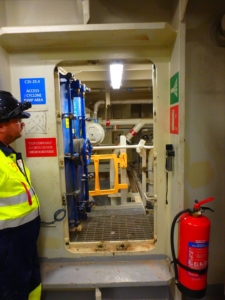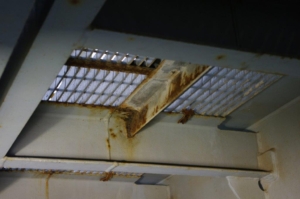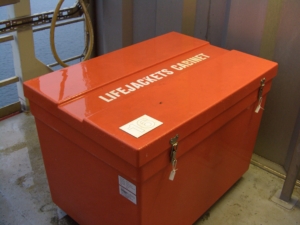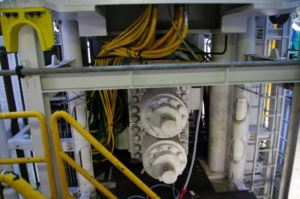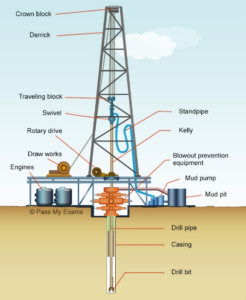Notes concerning rig inspections:
Note 1: The drilling inspection consists of a review of the rig equipment, using check lists.
At this occasion, a review of the Contractor procedures should also be initiated and completed prior to Commencement Date:
Well control and killing procedures, emergency procedures (H2S, shallow gas …) must be compatible with COMPANY policy and local constraints and regulations. Any difference shall be solved in writing
Note 2: It is often preferable to carry out the SEV (safety, environment & verification inspection) at the very beginning of the operations, as this enables to check both the ancillary equipment rig up on the site (for ex., mud treatment on onshore wells, service company equipment, lighting, posting), and the actual safety organisation put in place.
A safety representative, nominated by the Contractor, and belonging to the Contractor Base Staff, should be present on the rig during the safety inspection. For information purposes, appendix x provides the list of safety documents to be provided by the Contractor to the SEV inspector and the scope of function tests made by SEV at this occasion. Appendix x gives as a reference document the description of a medical treatment unit and the minimum recommended inventory of an ambulance. For information, the Company’s Safety and Environment Protection Minimum Standards is detailed as a separate appendix in the standard Drilling Contracts and can serve as a guideline for the Safety audit.
Note 3: The mechanical and electrical inspection must include a detailed BOP and well control equipment inspection. In the case of a long-term contract, HP/ HT well, or of expected delicate drilling conditions, it is recommended to dedicate BHO for the BOP inspection, in addition for the remaining items. Alternatively, Subsidiaries may be contracted for the full inspection.
Electronic and software has become more and more important part of the inspection and verification on a rig. BHO have expert personnel for this type of inspection and verification.
Special attention.
During this inspection, a special attention must also be paid to the equipment often at the origin of many handling accidents: lifting, handling, and hoisting gear, rig floor tools, various subs used for handling/circulation… Aspects such as maintenance scope and frequency, tests, regular NDT inspections, W.L.L.’s should be thoroughly checked.
A detailed inspection programme of the lifting gear is proposed to be made. This programme can be used as a reference for any lifting gear detailed inspection.
Note 4: The CAA or similar expert while auditing the contracted helicopter service company will review the helideck and related facilities. This should be done as early as feasible.
Note 5: Marine Hardware not only concerns the mooring equipment of floating units (Tender barges, Semisubmersibles, Drill ships), but also applies to all supply and stand-by vessels hired for offshore operations. During this inspection, the capacity to handle any emergency involving the use of marine equipment (emergency move off, degraded situation during a rig move…) must be thoroughly checked. This concerns equipment, its maintenance and certification, emergency procedures, and periodical tests.
- RIG COMMISSIONING/ ACCEPTANCE
Rig Commissioning is also part of Company Safety Policy. It consists of operational reception tests and shall be carried out on the first well location.
Rig Commissioning aims at checking, before and / or after the COMMENCEMENT DATE, which the functional reliability and the pressure integrity of the equipment are actually consistent with the rated capacities. Several functional and pressure tests shall be done to achieve this tight control.
RECOMMENDATION: Rig Commissioning and or Acceptance is a mandatory operation and shall be carried out by the BHO rig intake management.
Up to 96 hours after the COMMENCEMENT DATE are allocated to this important task.
Once the reception tests have been completed, BHO Rig Intake Manager / lead or the one who is appointed to do so should sign a provisional acceptance certificate, stipulating that the Company certify its acceptance of the rig “X”, subject to satisfactory completion of outstanding items, if any, such items not being critical. For contractual aspects, refer to COMPANY standard drilling contract.
- ROUTINE INSPECTIONS
a). Operational Safety Leader (OSL)
The responsibility for safety during drilling and well operations lie with the line management, in relation with everyone’s duty. This responsibility cannot be delegated. However, the effectiveness in reaching safety objectives is enhanced by the nomination, in each subsidiary, of an Operational Safety Leader (OSL).
Depending on subsidiary’s size and organisation, he may or may not be entirely dedicated to this task. Conversely, two OSL’s may be nominated, for ex. one for drilling and one for well activities. He does not have as OSL the responsibility of the operations, but he should be closely associated to them, and his scope should cover both drilling and work over operations, and existing wells routine activities.
His responsibility is to promote safety matters: mainly to propose improvements, to monitor the implementation of safety measures and to motivate personnel.
More precisely, his duties are:
1; carrying out on site monthly safety meetings on all Drilling & Workover units or ensuring that they are carried out by the operational staff.
Monthly Safety Meetings are a key point of our BHO / Company
Safety policy: they are the best opportunity for rig supervisors to address safety problems, in particular those, which have to be solved with the support of the office. They should include a review of the past reported anomalies and incidents, results of monthly safety inspections, follow up of the pending points from the punch list established during the previous month and definition of actions to be launched.
The Toolpusher, rig safety rep., other contractor’s representatives whenever available, and the Drilling supervisor should attend monthly safety meetings.
2; carry out in office quarterly safety meetings with Contractors management representatives. The objective is to motivate all Contractors, and not only the rig Contractor, to safety issues. To be attended by all service companies, rig contractor safety rep., base manager, and subsidiary drilling manager. Topics: review of past incidents, review of corrective actions currently launched, and definition of safety objectives.
Service companies must also be encouraged to carefully prepare their own messages, prior to the meeting and take an active part.
3; Motivating site supervisors and contractors towards a positive attitude towards Safety: promote reporting of anomalies, near misses and accidents, how to analyse and to prevent them, and how to mitigate their consequences.
4; Carry out major accident investigations, be the leader for the Cause Tree Analysis investigation, whenever appropriate.
5; Ensuring that BHO / Company Safety rules are dispatched, agreed by everyone, and complied with (both at working site and office), and promoting the application for derogations, when necessary.
6; Preparing Safety Instructions, taking into account field specific problems and local regulations.
Safety Instructions include both Standard Instructions and dedicated instructions for a specific, non-routine job.
7; Forwarding Safety information to/ from BHO / Company.
- b) Monthly Safety Inspections
Checklists are provided in Appendix X, to carry out the rig site monthly inspection. This shall be done by field personnel, with the mandatory support of:
– The Drilling Superintendent, and/or,
– The Operational Safety Leader,
– The Contractor base Manager or his safety representative.
If either of these parties is not available, a delegate should replace them.
It is recommended to complete a specific part of the checklist every month, to pay a dedicated attention to a few specific topics, carefully selected with the rig Supervisor. A debriefing meeting shall be held on site once the inspection has been completed, and the punch list as per Appendix X filled up accordingly.
In case of long duration Contracts, an inspection programme should be set up, so that the full check list be covered at least once per year, or for medium duration campaigns, (6 months to one year), once during the campaign.
- c) Routine Safety Rep. Inspections
It is recommended that both BHO / Company subsidiary’s and Contractor’s respective Safety representatives carry out periodic inspections of each working site.
These inspections should be done at least every 3-4 months and more frequently if warranted. A site-debriefing meeting should follow them.
- d) Routine Rig Surveys
For long term contracts (> 1 year), a full survey with BHO or other must be carried out on a yearly basis, so as to check the current rig status, especially the items corrected since the last similar inspection, and to detect potential areas of concerns. The timing of the inspection must be coordinated with the surveyor, so that BOP internals can be fully checked without perturbing the ongoing rig operations.
Similarly, BHO’s Subsidiary’s safety representative should conduct at least once a year and if possible, with the Contractor Safety Rep., a routine survey for safety appliances.
Aeronautic and marine routine surveys may also be requested by the Subsidiary, depending on the rig site operating conditions.

